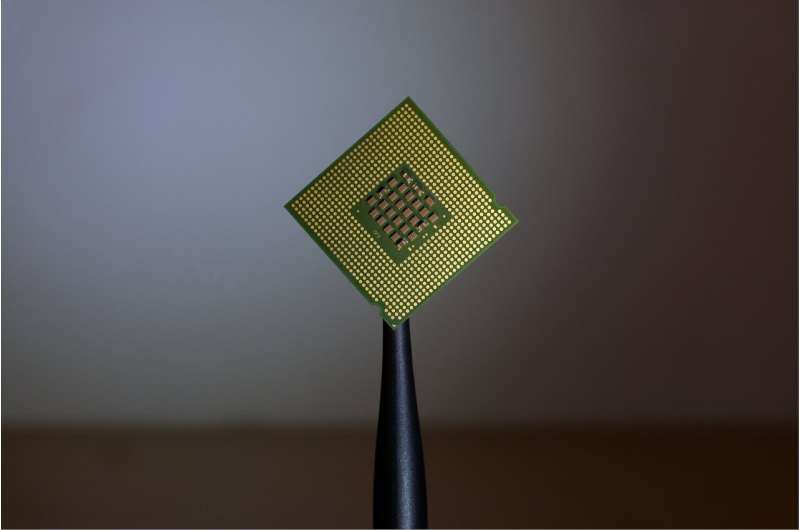Credit: Brian Kostiuk on Unsplash
To operate safely and reliably in outdoor environments, electronic devices should be resistant to a wide variety of external factors, including radiation. In fact, high-energy radiation can damage several components of field-effect transistors (FETs) commonly used to make electronics, including their semiconducting channel, gate oxide and the insulating materials surrounding it (e.g., isolation or substrate oxides).
For several years, research teams worldwide have thus been trying to devise strategies that could make transistors more resistant to radiation. So far, however, this has proved to be highly challenging, and only a few of the techniques proposed in the past have achieved promising results.
Researchers at Peking University, the Chinese Academy of Sciences and Shanghai Tech University have recently fabricated a radiation-hardened and repairable integrated circuit (IC) based on carbon nanotube transistors with ion gel gates. This IC, first presented in a paper pre-published in Nature Electronics, could be used to build new electronic devices that are more resistant to high-energy radiation.
"Our work aimed to realize a kind of radiation-immune IC," Zhiyong Zhang, one of the researchers who carried out the study, told TechXplore. "In addition to general-purpose chips, the requirements on radiation-hardened electrical devices and integrated circuits are growing fast due to the rapid developments in the space exploration and nuclear energy industries."
Most previously proposed strategies to make electronics more resistant to radiation are designed to harden only single components of an electronic part. As a result, using them to create transistors and ICs that are fully resistant to ultra-high radiation can be difficult.
In their paper, Zhang and his colleagues introduced a new strategy that enables the realization of transistors and ICs that are wholly immune to radiation-related damage. The approach they devised essentially entails the redesign of all the vulnerable parts of FETs and the use of new materials that are more resistant to radiation. In addition, the researchers introduced a method to recover FETs via a heat treatment process known as annealing, which they carried out at moderate temperatures.
Credit: Zhu et al.
"The fabricated ICs based on this type of FET present high radiation tolerance of up to 15 Mrad, which is much higher than that of Si transistors (1 Mrad)," Zhang said. "The combination of high radiation tolerance and thermal recoverability paves the way for the development of a new technology of radiation-damage-immune ICs."
The radiation-hardened IC has a semiconducting carbon nanotube transistor (CNT) as a channel, an ion gel as its gate and a substrate made of polyimide. CNTs are intrinsically radiation-resistant semiconductors due to their strong C-C bonds, nanoscale cross sections and their low atomic number. Therefore, in their study, the researchers primarily focused on trying to make their IC's gate insulator and substrate more resistant to radiation.
"When designing our radiation-immune IC, we drew inspiration from the liquid metal robot T-1000 in the classic science fiction movie 'Terminator 2,'" Zhang said. "We used a quasi-liquid gate insulator—ion gel and a 'transparent' substrate. Ion gel gates promote the formation of EDLs at the surface of the CNT channel, which provides a much higher gate efficiency and allows the gate to be recovered after suffering radiation damage. Meanwhile, by replacing the Si/SiO2 substrate of a conventional FET with a thin polyimide substrate, we eliminated effects resulting from high-energy particles being scattered and reflected in a heavy and thick substrate."
In addition to developing an IC with a high tolerance to radiation, significantly higher than that of traditional silicon-based transistors, Zhang and his colleagues introduced a method that could be used to recover FETs damaged by radiation. More specifically, they found that radiation-damaged FETs could be repaired by annealing them at a moderate temperature of 100 °C for 10 min.
In the future, the method for fabricating high energy radiation-resistant transistors and ICs devised by this team of researchers could enable the development of durable and more robust electronics that can operate in unusual and potentially problematic environments. For instance, the IC they developed could be used to create electronics that can be sent into space or devices for the nuclear energy industry.
"The transistors and ICs demonstrated in this work are just prototypes," Zhang added. "We will now try to improve the performance and integration density of the IC by scaling the CNT FETs and optimizing the structure and process. In fact, this kind of radiation-hardened IC only has practical value if its performance and density reach certain thresholds."
More information: Radiation-hardened and repairable integrated circuits based on carbon nanotube transistors with ion gel gates. Nature Electronics (2020). DOI: 10.1038/s41928-020-0465-1.
Journal information: Nature Electronics
© 2020 Science X Network
























